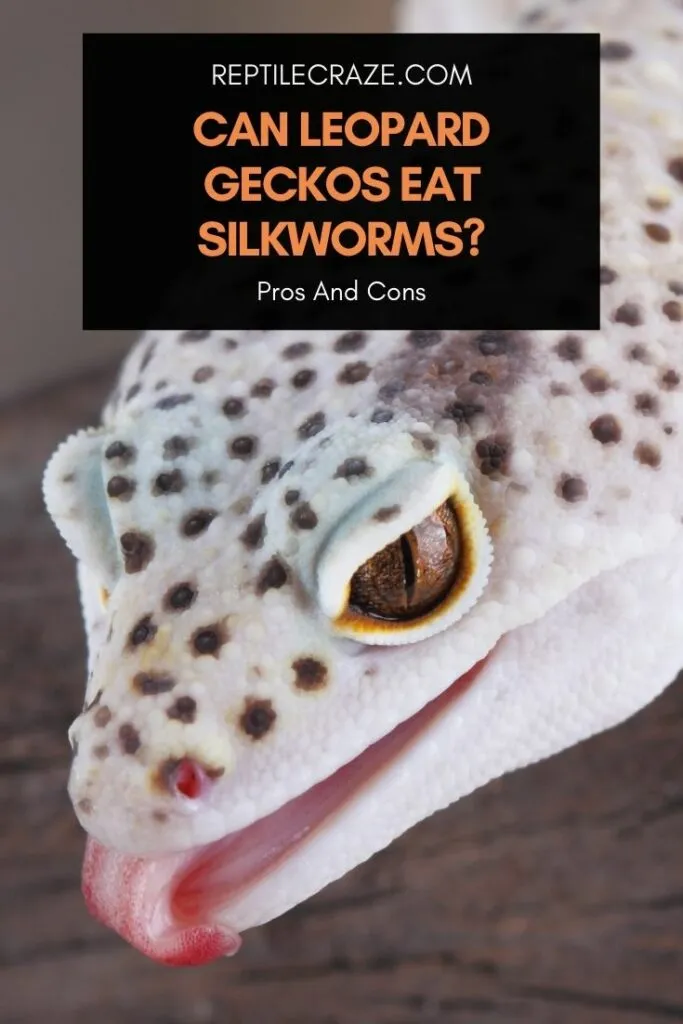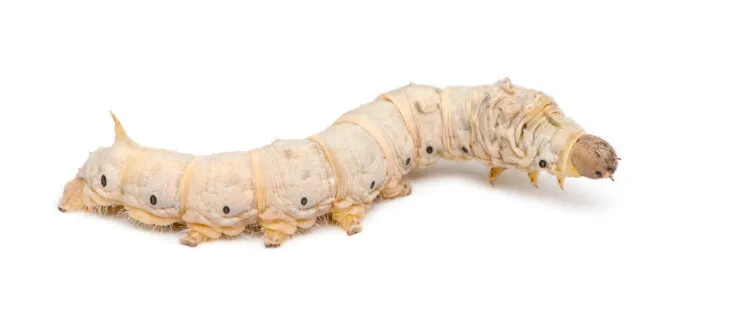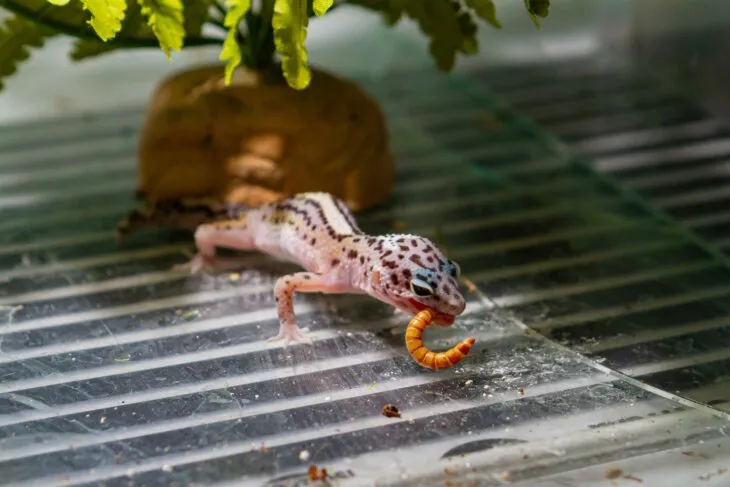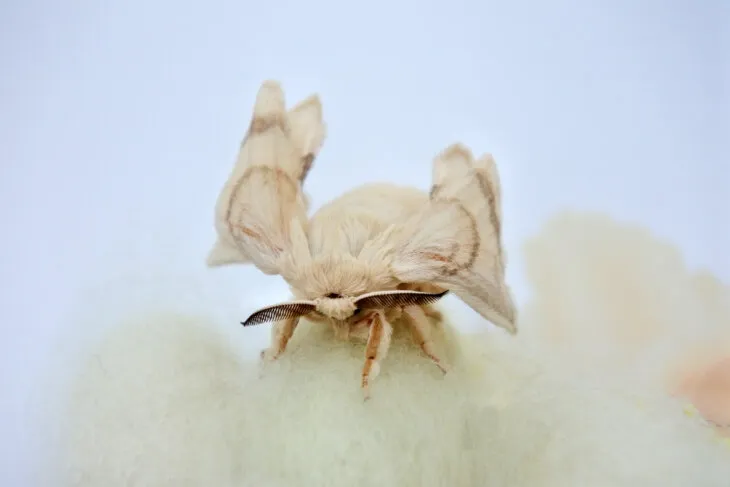
Silkworms (Bombyx mori) are emerging as a solid feeder choice in the leopard gecko community, increasing curiosity about the species. If you’ve been wondering whether silkworms would suit your reptile in terms of nutrition and expense – you’ve come to the right place.
Silkworms are an excellent diet option for leopard geckos due to their high moisture and low fat content. However, silkworms can also be problematic because they’re expensive, not always readily available, and are challenging to care for at home.
Thankfully, this article is designed to help anxious gecko owners make an informed decision. Scroll below to discover the pros and cons of feeding leopard geckos silkworms, adequate feeding quantities, and much more.
Table of Contents
Are Silkworms Healthy For Leopard Geckos?
Silkworms are perfectly safe for leopard geckos to eat. However, understanding the benefits they can add to your gecko’s diet requires a quick nutritional breakdown first.
| Insect Name | Silkworms (larvae) |
| Moisture % | 82.7 |
| Protein % | 9.3 |
| Fat % | 1.1 |
| Calcium Mg/Kg | 177 |
| Phosphorus Mg/Kg | 2370 |
High Moisture Content
Like all living things, leopard geckos need water to survive. They generally derive the bulk of moisture they need from the insects they eat, making it imperative for their meals to have a substantial moisture content.
Silkworms come highly recommended in this category, with a moisture level of 82.7 percent. If your gecko is the sort not to drink water too often (like most leos), feeding it a regular diet of silkworms will undoubtedly help keep it hydrated.
Dehydration isn’t uncommon among leopard geckos and can interfere with critical physiological functions, such as digestion, vitamin absorption, and organ function.
That’s where feeding your recovering gecko silkworms can come in handy because their natural water content will help your gecko rehydrate much faster.
Ample Protein
Protein is another essential component of a gecko’s diet. Derived from amino acids, proteins aid in various biological functions, such as cell repair, muscle construction, and the formation of enzymes and antibodies.
Silkworms boast 9.3 percent of protein, making them a good nutriment, especially for sick or gravid geckos, because their protein requirements are higher.
Gecko owners looking for a staple meal prospect can rely on silkworms. Regardless, experts recommend a varied menu so that your reptile’s diet includes all the required essential amino acids.

Adequate Fat
Gecko owners often run into problems picking out suitable insect feeders because of their high-fat content. Luckily, that’s not a concern with silkworms, as they include 1.1 percent of fat.
That means gecko owners looking to help their reptiles with weight maintenance or weight loss can add silkworms to their diet without too much worry.
However, it’s also important to remember that fat provides energy concentration. Fats include essential fatty acids, which aid the development of prostaglandins (lipid compounds that help processes like inflammation and reproduction).
Likewise, it’s best to strike a balance between feeding your gecko silkworms and several other healthy insects to make sure their overall nutritional needs aren’t compromised.
Source Of Calcium
Most, if not all, gecko owners are worried about their pets’ calcium intake to avoid calcium deficiency problems like metabolic bone disease.
This is another reason why silkworms are a convenient feeder alternative because their calcium and phosphorus content clocks in at 177 and 2370 Mg/Kg, respectively.
To put things in perspective, leo owners should know that silkworms have the same calcium range as superworms.
They also beat butterworms (125 Mg/Kg) in this category but offer less of the mineral than soldier flies (larvae) with a 9,340 Mg/Kg calcium content.
Generally, dusting silkworms with calcium or multivitamins isn’t recommended because their smooth exterior doesn’t retain much powder.
However, this is only true if you’re dusting everything else you’re feeding your leopard gecko.
Vitamins And Minerals
Silkworms contain several vitamins and minerals, particularly Vitamins A, B1, B2, and B5. Vitamin A helps aid the immune system and ward off respiratory and digestive tract infections.
Other Benefits
Now that we’ve covered the nutritional advantages of silkworms as part of a leopard gecko’s diet, let’s focus on the benefits gecko owners might derive.
Silkworms don’t need to be gut-loaded because they consume mulberry leaves or a mulberry leaves-based prepared diet. That means you don’t have to expend extra time or effort ensuring the worms are ready to be fed to your reptile.
Another advantage of housing silkworms as leopard gecko grub is that they’re slow-growing, meaning they’ll last a good while (when provided ideal settings).
And finally, silkworms are also pretty slow-moving. That means you can either use a bowl or tong-feed your leopard gecko without having to worry about the worms making an escape.
Tip: If you would like to learn what the best worms for leopard geckos are, read our guide here!
Are There Any Disadvantages To Feeding Leopard Geckos Silkworms?
Gecko owners looking to make an informed decision about adding silkworms to their geckos’ diet need to be aware of any disadvantages related to the situation.
The good news is, nutritionally speaking, feeding your gecko silkworms has no drawbacks, but there are other concerns.
Here’s what some of them are:
Availability
You may run into problems when buying or housing silkworms. To begin with, silkworms aren’t always readily available in local stores and will generally need to be acquired via online purchases.
The life cycle of a silkworm ranges between six to eight weeks, and the warmer the weather is, the quicker its lifecycle will progress.
That’s one reason why most gecko owners prefer to buy silkworm eggs to hatch and house them at home for a prolonged life cycle.

Growing Requirements
Housing and feeding silkworms can be expensive and not suitable for everyone. Silkworms require temperatures between 78 to 77 F and a diet of mulberry leaves to thrive.
This means gecko owners need to invest in trays or containers for housing, incubators for temperature control, and mulberry leaves for feeding purposes.
If you’re not looking to spend extra cash on feeder alternatives, silkworms might not be the best option for you.
Susceptibility To Diseases
Silkworms are also susceptible to viral and fungal diseases, significantly affecting their numbers. That means growers have to be careful about maintaining ideal temperature and housing conditions to avoid losing the worms to any sickness.
Overall Costs
Perhaps one of the biggest drawbacks of home-growing silkworms is the expense involved in the process. In short, growing silkworms at home as feeder insects for leopard geckos requires time, effort, space, and money.
It’s not something all gecko owners can easily commit to, making silkworms a little troublesome for a staple diet.
How Many Silkworms Can You Feed A Leopard Gecko?
Figuring out how many silkworms to feed your leopard gecko can be a little tricky because it depends on several factors like your gecko’s size, health, and the size of the silkworms themselves.
The silkworm goes through five larval instars (or growth stages) before it’s ready to cocoon. Upon hatching, the silkworm larvae measure approximately one-eighth of an inch, making them too small for gecko consumption.
By the third and fourth instar, silkworms are generally sizable enough to be ready for consumption. At this point, you can feed your leopard gecko two silkworms per every inch of your gecko’s size.
For example, if your gecko is four inches long, you may provide your reptile eight silkworms in one feeding.
We’ve also included a useful feeding chart below. However, gecko owners are advised to refer to the table as a guideline and tweak feedings according to their pets’ age, health, and other requirements.
| Age | Number of Silkworms |
| Baby Leopard Geckos (0 to 6 months) | 5 to 10 silkworms (3/8 to 1/2 inch) – every day |
| Juvenile Leopard Geckos (6 to 10 months) | 6 to 10 silkworms (1/2 inch plus) – 4 to 5 times a week |
| Adult Leopard Geckos (10 months and beyond) | 6 to 12 silkworms (1 to 1 1/2 inches) – 2 to 3 times a week |
Can Baby Leopard Geckos Eat Silkworms?
Baby or juvenile leopard geckos can be fed silkworms as they’re a good source of protein and calcium. Still, it’s best to feed baby geckos small-sized silkworms (ranging from 3/8 to 1/2 inches) to ensure they’re easy to swallow and digest.
Gecko owners should also note that silkworms aren’t too high in fat and may not be enough to provide for a growing gecko’s energy needs alone.
Can Leopard Geckos Eat Silkmoths?
The life cycle of a silkworm contains five stages: egg, worm, cocoon, pupa, and moth. As the name suggests, silkworm moths are what the larvae of Bombyx mori eventually transform into.
As such, leopard geckos can eat silkmoths safely.
However, the wingspan of an adult silkworm moth is just under two inches, making it unsafe for juvenile leos. The good news is silkworm moths don’t fly due to many years of domestication.
You can feed your adult leopard gecko silkworm moths without having to worry about the insect flapping out of the enclosure.
Still, we recommend checking our guide on feeding leopard geckos moths here before trying that out.

Where Can You Buy Silkworms From?
Leopard gecko owners looking to acquire silkworms for their reptiles can easily do so from reputable egg suppliers (for the egg form) or enterprises such as Josh’s Frogs which specialize in insect feeders for reptiles.
However, before ordering silkworms online, make sure to do your due diligence by verifying the source and reading the fine print for details such as live-product guarantees, after-sales services, discounts, etc.
Conclusion
Silkworms can make a welcome addition to a leopard gecko’s diet because of their high moisture, calcium, and protein quotient. They are also easy for leos to digest, thanks to their soft bodies.
Nonetheless, at times, silkworms aren’t readily available, leading to gecko owners resorting to growing the worms from eggs.
Growing and housing silkworms can require significant effort and can be costly, which is burdensome.
If you can manage to get your hands on live silkworms, they are a nutritious feeder option that gecko owners can rely on for a healthy diet.
- Enchi Ball Python: A Unique and Stunning Morph of Python regius - March 27, 2025
- Emerald Tree Monitor: The Enigmatic Green Guardian of the Rainforest - March 26, 2025
- The Egyptian Cobra (Naja haje): A Fascinating Serpent - March 25, 2025
